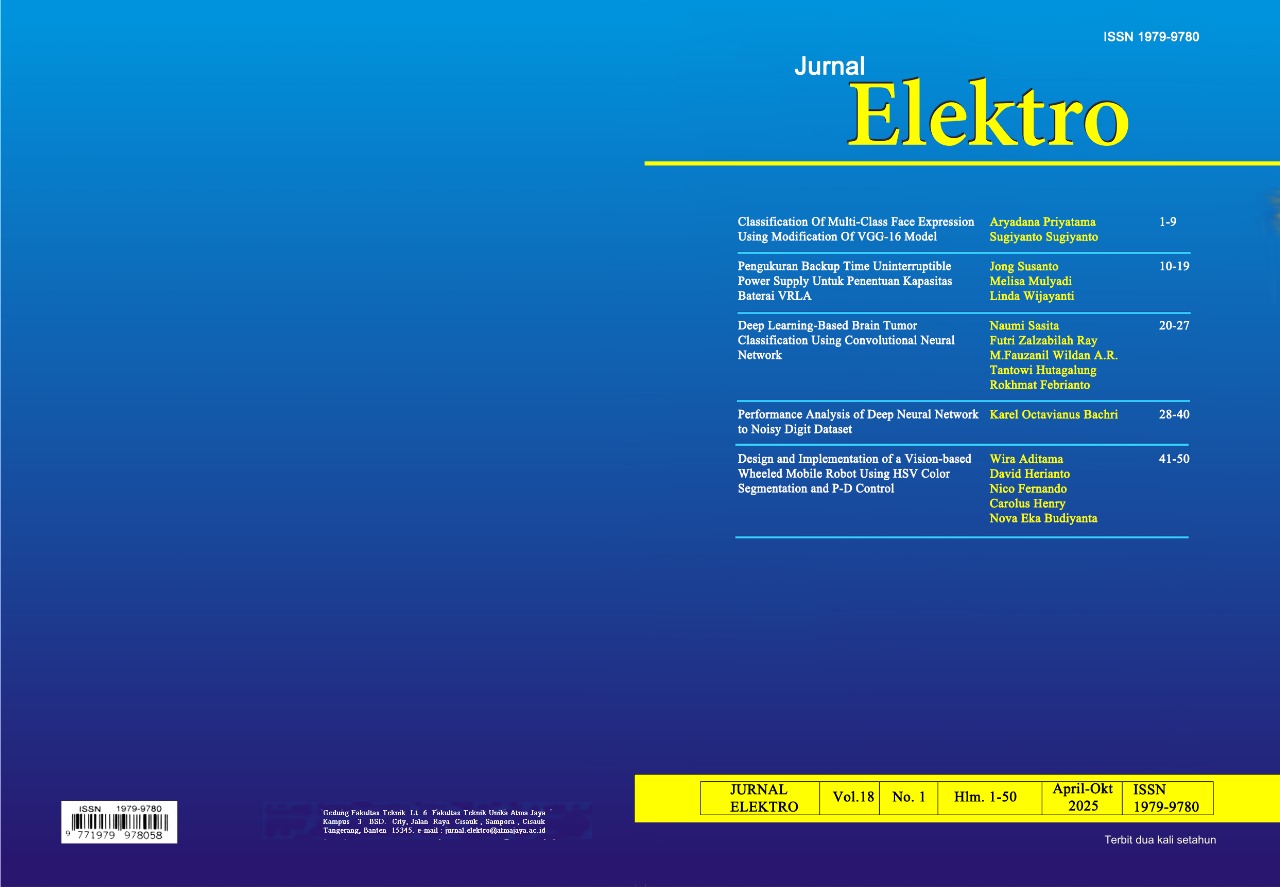Deep Learning-Based Brain Tumor Classification Using Convolutional Neural Network
DOI:
https://doi.org/10.25170/jurnalelektro.v18i1.6658Keywords:
Brain tumor detection, Deep Learning, Medical Imaging, MRI, Resnet50Abstract
An essential noninvasive medical diagnostic technique is magnetic resonance imaging (MRI), which is particularly useful for identifying brain cancers. While earlier algorithms proved effective on smaller MRI datasets, their performance suffered on bigger datasets. This study addresses the need for a swift and reliable brain tumor classification system capable of sustaining optimal performance across comprehensive MRI datasets. The convolutional neural network is implemented using the Keras library, incorporating the ResNet50 architecture as a pre-trained model. The ResNet50 model is fine-tuned for the specific brain tumor classification task, with a Global Average Pooling layer, dropout, and a final dense layer with softmax activation. Data augmentation techniques are employed to enhance the model’s robustness, including rotation, width and height shifts, and horizontal flips. The training process involves optimizing the model using the Adam optimizer with a learning rate of 0.0001. Early stopping, learning rate reduction on plateau, and model checkpointing are implemented as callbacks to ensure efficient training and prevent overfitting. The proposed model achieves a remarkable accuracy of 99.28 percent after 15 epochs. The classification task involves distinguishing among four classes: glioma, meningioma, pituitary, and no tumor.
References
J[1] J. Kang, Z. Ullah, J. Gwak. ”Mri-based brain tumor classification using ensemble of deep features and
machine learning classifiers,” in Sensors, vol. 21, no. 6, pp. 2222, 2021.
[2] P. Abdalla, B. Mohammed, A. Saeed. ”The impact of image augmentation techniques of MRI patients in
deep transfer learning networks for brain tumor detection,” in Journal of Electrical Systems and
Information Technology, vol. 10, no. 1, pp. 51, 2023.
[3] M. Hafeez, C. Kayasandik, M. Dogan, ”Brain Tumor Classification Using MRI Images and
Convolutional Neural Networks,” in 2022 30th Signal Processing and Communications Applications
Conference (SIU), 2022, pp. 1–4.
[4] N. Varuna Shree, T. Kumar. ”Identification and classification of brain tumor MRI images with feature
extraction using DWT and probabilistic neural network,” in Brain informatics, vol. 5, no. 1, pp. 23–30,
2018.
[5] Noreen, N., et al. ”A deep learning model based on concatenation approach for the diagnosis of brain
tumor,” in IEEE Access, vol. 8, pp. 55135–55144, 2020.
[6] Lin, J., et al. ”CKD-TransBTS: clinical knowledge-driven hybrid transformer with modality-correlated
cross-attention for brain tumor segmentation,” in IEEE transactions on medical imaging, 2023.
[7] M. Güler and E. Namlı, ‘Brain tumor detection with deep learning methods’ classifier optimization using
medical images’, Applied Sciences, vol. 14, no. 2, p. 642, 2024.
[8] A. Chattopadhyay, M. Maitra. ”MRI-based brain tumour image detection using CNN based deep learning
method,” in Neuroscience informatics, vol. 2, no. 4, pp. 100060, 2022.
[9] Noreen, N., et al. ”A deep learning model based on concatenation approach for the diagnosis of brain
tumor,” in IEEE Access, vol. 8, pp. 55135–55144, 2020.
[10] M. Siddiqi, M. Azad, Y. Alhwaiti. ”An enhanced machine learning approach for brain MRI
classification,” in Diagnostics, vol. 12, no. 11, pp. 2791, 2022.



